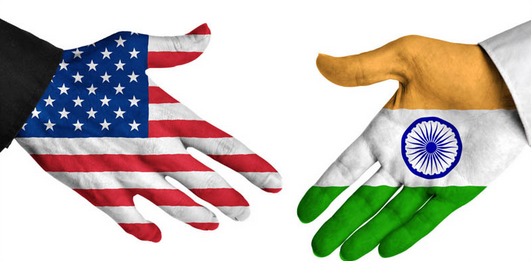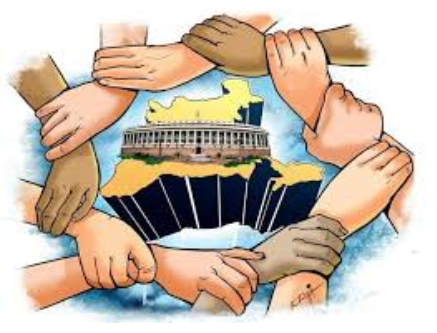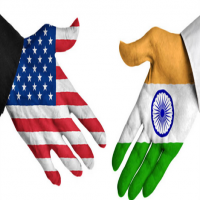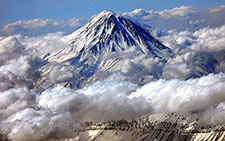“Few regions of the world are fraught with as many security questions as Asia. Within this region it is possible to study great power rivalries, irredentist conflicts, nuclear and ballistic missile proliferation, secessionist movements, ethno-religious conflicts, and inter-state wars. 1”

In the name of God the munificent the merciful
India’s direction in our transitional world is one of the subjects of future studies, because India’s movement and position in this regards is one of the world trend determinants. Therefore finding where India is going and how would be the world that India and some other will stand on its top, is a subject matter of world’s movement observes. With this approach this article by using Kuhn’s Paradigm theory and putting the 123 Indo-US Nuclear Deals as a turning point in India world policy, tries to show India direction in regards with policy. India’s flicker steps towards the U.S campus started by its economic reforms in 1990s and ultimately revolutionized to a Strategic Partnership point by the 2005 Bush-Singh nuclear deal. Despite of the on-going trend, what the future will become is the question that future should answer to it, this article tries the best to clear on-going India world policy.
Thomas Samuel Kuhn (1922-1996) by writing its masterpiece, The Structure of Scientific revolutions 2 in 1962, brought the notion of “Paradigm” as a scientific theory or useful method and tool in scientific analysis, to existence. Although Kuhn‘s theory was pointed towards natural sciences, but found itself more successful in social sciences and was most welcomed by the social scientists campus and subsequently made a revolution in analyzing social phenomenon and showed itself effective in “problem solving” of social fields. Kuhn’s method was the outcome of his supremacy over historical trends and theories of physics and the philosophy of science. This article finds Kuhn’s theory as a suitable tool to analyze the 2004-9 India National Congress (INC) ruling over India, period and signing of the Indo-American Nuclear Deal. So having a look at the structure of Kuhn’s theory will clear our way to answer questions such as: Is India really entered in liberalized paradigm? And Is India now in “normal science” era of liberalized paradigm? Especially this article will have a look on the nuclear deal between India and United State of America (U.S.A) as a core issue in this regard.
The paradigm takes meaning in the concept of “normal science” that “for a time provides model problems and solutions to a community” (Kuhn 1996 px). Normal science or conventional period of a science is placed against “Scientific Revolution”, the trend that every science experiences during their history and the development of any science will happen throughout the shifting of normal science and the scientific revolution. In Kuhn’s theory, paradigm is what the members of a scientific community share, seen by others as the sole idea responsible for the pursuit of a set of shared goals, for instance the training of their successors. Both normal science and revolutions are community-based activities.
Kuhn’s theory, is trying to have a clear explanation on how one dominant scientific theory at the exact era of its being, is entering in its normal science phase, to have “puzzle-solving” role or ability to find “acceptable solution” for suppositious problems of a science. It wants to say how a “scientific community” shapes around a theory or how they interact with each other, and when a dictated paradigm encounters with its weakness period by facing “Anomalies” that as a result make question on its credibility, then what will happen to its supporters, and by which mechanism, a formed scientific community terminated by appearing hesitation over its scientific ability to solve its followers problem and showing their way in future, and gradually leads the paradigm to a scientific revolution point and ultimately it shifts from an exist paradigm to a new one. Or why one paradigm is replaced by another one and how would be the quality and procedure of “shifting”. Furthermore, Kuhn showed the mechanism of “incommensurability” among different paradigm devotees and competing paradigms, and how the two groups of scientists see different things at the time that they look from the same point in the same direction.
Paradigm in some way is a kind of a “Structure” theory. One of its goals is to analyze the normal science structure that a paradigm has come to exist in it. Kuhn believes that when anomalies shake the foundations of a dominant paradigm, it will alarm for a “crisis” that perhaps it will be evidence for the time of scientific revolution and necessity of emerging new theory and a paradigm that finally should have more capacity for problem solving. Kuhn’s examples show that each of normal science during the history of a science tasted being in the position of normal science and they passed “pre and post-paradigm” atmosphere and scientific revolutions, change them till now.
Kuhn’s “common Disciplinary (as common possession of the specialists of a particular discipline) Matrix (a composed of ordered elements of various sorts, each requiring further specification)” or on other hand paradigm, is a community of scientists with common values, methods, tools and techniques, and also with a unification of theoretical and even metaphysical approach, gathers them around it, and finally replaced by their successor through a scientific revolution path.
The founder of Paradigm theory by using some other scientific theories as example wants to say, it is a common trend of all sciences and it is repeated during scientific history each paradigm would not taste a permanent position and this cyclic will repeat in future. He believes that when a scientific revolution happens it would revises the community’s perspective that experiences it, and that change, effects the structure of post-revolutionary textbooks and research direction and gradually its publication, also by starting of the Normal science era, some particular scientific community acknowledges for a time shape as supplying the foundation for further practice around an accepted model or pattern that he name it paradigm, that its work is to sets the problem to be solved.
Normal Science or an established paradigm in some way make a kind of conservative atmosphere and its scientists try to save it, so it directs to articulate of those scientific phenomena and theories that the paradigm already supplies. A Successful paradigm tries to solve its member’s problems and save its scientific achievements to make them permanent. And on-going fact-gathering, is at the service of paradigm stabilization and its conformation to fix it more.
A paradigm’s aim is to display the order by approve its long accepted belief by a sets of repeated scientific problem-solving process. Every skilled member of a paradigm community also engages in puzzle-solving process that till a time has not been solved by others. This scientific forward movement will continue till a scientist faces a situation that the on-going law or the theory doesn’t work well. This kind of scientists always can evaluate its weak points so they suggest new way for their scientific problem solving and their logic suggestion will attract community to change direction and progressively a scientific revolution lead them shift to a new paradigm, although some fanatic and conservative scientists may show resistance to conserve an on-going normal science, but the majority of its community will approach the new theory and finally shape a new paradigm that could determine a new normal-science era that brings by a community with shared beliefs.
It should be clear that scientific paradigm shifts or change, could have deferent angle size, so a science can face with deferent size of scientific revolution or changes, it could range in a spectrum from small to very large ones, it should be mentioned that new sort of facts or any important change in an on-going paradigm perception, does not necessarily lead to a paradigm shift. But it is clear that when serious anomalies appear and crisis hits a paradigm, it leads to large-scale change, at this time scientists usually develop theoretical concepts which can themselves point the way to discovery new theory and the new successful one would become a paradigm. It is also noticeable that new discoveries are not the only destructive or constructive source of paradigm changes, the source of crisis can be any problem (that considers in normal science as a puzzle) or anomalies that can be seen as a counter instance. The crises will lose the rules of normal puzzle-solving or the rules for normal research and paradigm-nature fit, ultimately it leads to increase varieties of the paradigms and at the end of the day it will permit a new paradigm to emerge and dominate the science. When transition from one paradigm to other one is complete, the career will have change its view of the ground, its methods, and its goals. It’s a fact that crisis alone is not enough for shift.
Paradigms play as form-giver to scientific atmosphere and as a vehicle for scientific theory, it determine each entity in which way, should behave. Paradigm also clears nature of scientific research, as Kuhn said “since nature is too complex and varied to be explored at random, that map is as essential as observation and experiment to science's continuing development. Through the theories they embody, paradigms prove to be constitutive of the research activity”. (Kuhn 1996 p109) Paradigms supply scientists a map and the directions that is essential for map-making.
Paradigm’s Textbooks are educational vehicles for the continuation of normal science. After a scientific revolution, post-revolutionary science activity will start to reconstruct history of science that is regularly completed by its texts. Kuhn believes that a series of individual discoveries and inventions, group together and represent the modem body of technical knowledge. He refers to paradigm testing conception that arises only after persistent failure to solve an important puzzle has given rise to crisis. Testing occurs as part of the competition between two rival paradigms of a scientific community. Kuhn also confesses that no theory ever solves all the puzzles which are confronted at a given time; nor is the solutions already achieved often perfect.
Kuhn as physicist who shifted to philosophy says, if all followers of a community answer back to each anomaly as a source of crisis or involve each new theory advanced by an associate, science would stop, or if no one react to anomalies or the brand-new theories in high-risk ways, there would be few or no revolution and as result no develop in sciences.
By these explanations, now a look at the signed strategic US-India nuclear deal, as a second political, technological as well as commercial key step on the road to a shifting in India’s world policy, will clear the new Indian paradigm, internally and externally. Oxford-educated economist, Mr. Manmohan Singh (1932- ) completed his first major revolutionary step, which became operational through his liberalization of economic reforms when he served as Finance Minister during Prime Minister P.V. Narasimha Rao (1991–1996). India’s entering in its new world policy phase got more completed when in 2005 G. W. Bush and Manmohan Singh signed 123 Agreement 3, concerning the Indian nuclear issue. It could be considered as a revolutionary change for India’s path toward the US, as well as others, mostly in the West Bloc. “The 123 Agreement has been widely seen as a strategic coup for both states 4”. Some main steps forward after this agreement are:
a) The Hyde Act passed by American Congress, to enable its government to consider India as an exception in U.S.A nuclear non-proliferation policy and made it able to transfer sensitive technology to India in this regards. b) It facilitates India-IAEA 5 agreement for safeguarding India’s civil nuclear reactors. c) It also make possible an agreement with NSG 6 so the nuclear weaponized India, became able to buy nuclear fuel, etc without signing the NPT 7.
“The 123 Agreement has a clear purpose: to "enable full civil nuclear energy cooperation between the Parties. peaceful nuclear cooperation and not to affect the unsafeguarded nuclear activities of either Party (Article 2 of 123)” the first time that a state possessing nuclear weapons outside the framework of the NPT, namely India, has had its civil nuclear energy program "brought into the fold." 8.
The question is how new paradigm came to exist and got shaped, when India and U.S.A situated in two opposite sides during previous world paradigm. In the Cold War era India’s problem-solver was the U.S.A rival, USSR, in front of the US-backed Pakistan as its operational enemy. The following fast changes in the world trend entered this two in new paradigm:
a) India’s Economic reforms changed it from a socialized unit to capitalized one. It happened as a major shift in India investment policy. b) Common values (democracy, English heritage, etc), c) Common security threat (terrorism, etc). d) Collapse of USSR. e) Post 2001 sep. 11 process, f) China as a common factor, as U.S.A wants to bring “China to a global liberal order” 9 and at the same time it was India’s biggest rival. g) U.S.A ambiguity about Pakistan as its previous ally in south Asia, etc,
These factors, plus some high rank delegations exchanging, during a decade, shift them to implement the Next Steps in Strategic Partnership (NSSP) in 2004 and progressively the natural allies entered in the new paradigm of cooperation and transformed them to a Strategic Partnership 10 in 2005 by signing the nuclear deal. From this time Indo-U.S.A partnership places in a new period and its new normal science atmosphere starts. They boost their assistance in some field that in the near past was iced. So, although Indian said no to U.S.A repeated world-wide invitation to presence in Iraq war and after it. In the new paradigm India started economic, political, financial, intelligence, etc operation in occupied-Afghanistan, beside U.S.A and others, which shaped the new alliance, was reacted by Pakistani side. Another case in this regard happened when a founder of NAM 11 took place in the World’s Powers campus side in IAEA and voted three times against Iran peaceful nuclear program.
This diversion in India’s world policy appeared as a puzzle solver in new paradigm for India, by a) Entering in cooperation with US military mechanism in South Asia 12 as well as cooperation with US East Asia partners 13, bilaterally and multilaterally. b) Improvement of Indian position toward its traditional rivals like China and Pakistan. c) Backing India’s demand for emerging as permanent member for U.N Security Council, formally by US highest 14 official rank. d) Improvement in Indo-U.S.A bilateral trade 15, etc.
But as Kuhn believes although paradigm is responsible for solving many problems, but it doesn’t solve all of them. So India’s policy-makers at the same time of moving in this trend, which sets them closer to US and its allies, they show their decision to diversify their international relation with other blocs of power, as well as second rank world’s power like the EU and its main members, or Japan. Also India had participated in the BRICS bloc (the countries that by 2030 will shape world new powers) 16 actively, and expanded its relation with some regional structures like ASEAN 17.
India is showing that it cannot rely to one side among world’s powers or its traditional mainstays in all aspects. For instance India is diversifying its energy supplier resources. So it is looking in Middle East, Central Asia, Russia, Africa, etc 18 for its energy resource need. In military filed also India at the same time that continues buying military equipment from its traditional suppliers like Russia, signed big deals with other main world supplier such as Israel, United State, France, etc. So Delhi became the destination of so many world leaders that try to sign new contract during last five years. The most important leaders like Barack Obama, Nicolas Sarkozy, Angela Merkel, and Vladimir Putin had selected Delhi as their trip-destination. In trade filed also India diversified its import and export targets 19. At least it can imagine four main scenarios for adopting such policy by Indian decision-makers:
A) It dedicates to a new-given role by world powers to new-India in new paradigm and so India is preparing itself for doing the job well.
B) It dedicates to the potential threats that India in new paradigm feels (From China, US side, etc) in future.
C) It shows an expansionist India that in new paradigm wants to come out of its traditional policy and follow an expansionist policy in the region.
D) Mix of the three items
India at the eve of 21st century faced a new world order, and as naturally every country by facing new paradigm will chose an exact puzzle-solving system for itself, India accepted solution for its problems like poverty, non-developing, low economic growth rate, long facing with powerful rivals like China, military weakness, etc was the on-going India world policy trend that has directed it toward closing to US campus. Whiles India since 1947 (Independence) till now at least had tasted two main paradigm; from 1950s till 1990s as a USSR ally, related to the main two super powers (U.S.A, USSR), and at the same time as major non-aligned member among the others. The second paradigm is started with two major steps, economic reforms toward capitalizing its economic rules especially investment, that are become operational in 1990s and finally signing 123 nuclear agreement in 2005 at the threshold of 21st century, that completed this process fairly during 21st first decade. So India steps toward its new paradigm as a destination that leads it to became Strategic Partner for US. Although these moves solved some of India’s problems, and internationally improved its position and its relationship with the world’s major players, but India’s behavior shows that it doesn’t feel confident and safe enough in this new mechanism. So this anomaly forces India to have some reactions. One the reaction that could be mentioned in this regard is increasing in India arm-expenditures and becoming first arms importer in the world, which a big competition to capture this new big market is going on between world’s largest arm-producers. At the time that India’s direction and move in transitional world is one of the important world’s trend determinants in future and now, putting the Indo-US Nuclear Deal as a turning point in India’s world policy would make clearer the path that India is going and maybe will go. But in some way India’s behaviors now, shows a kind of flicker steps toward US campus and despite of on-going trend in India’s policy, the future will answer to question of future.
References:
1- US–INDIAN STRATEGIC COOPERATION INTO THE 21ST CENTURY - ASIAN SECURITY STUDIES - US Army College - Edited by Sumit Ganguly, Brian Shoup, and Andrew Scobell - published 2006 by Routledge
2- The Structure of Scientific revolutions by Thomas Samuel Kuhn in 1962 - Third Edition in 1996 - The University of Chicago Press, Ltd., London © 1962, 1970, 1996
3- This name refers to Section 123 of the U.S.A-Atomic Energy Act that under this Act transfer of nuclear technology to other countries is banned.
4- http://www.reading.ac.uk/123agreement/123-project-overview.aspx
5- International Atomic Energy Agency
6- Nuclear Suppliers Group (NSG) is a group of nuclear supplier countries who seek the non-proliferation nuclear weapons. It was a reaction to India nuclear test in 1974
7- The Treaty on the Non-Proliferation of Nuclear Weapons, is an international treaty whose objective is to prevent the spread of nuclear weapons and weapons technology, to promote cooperation in the peaceful uses of nuclear energy and to further the goal of achieving nuclear disarmament and general and complete disarmament.
8- http://www.reading.ac.uk/123agreement/123-project-overview.aspx
9- http://gt2030.com/2012/06/01/the-indian-ocean-region-and-the-challenges-of-order-building-in-a-post-unipolar-post-western-world/ By Andrew Phillips
10- US-India Strategic Partnership: Implications for China – by Zhang Guihong - http://isq.sagepub.com/content/42/3-4/277
11- Non-Aligned Movement has 115 members. It came to exist in 1955
12- http://csis.org/files/publication/1203qus_seasia.pdf
13- http://csis.org/files/publication/1203qindia_asia.pdf
14- www.bbc.co.uk/news/world-south-asia-11711007
15- http://www.census.gov/foreign-trade/balance/c5330.html#2005
16- Four developing countries like Brazil, Russia, India, China establish it 2006 and in 2010 South Africa also attend to it.
17- Association of South East Asian Nations is a geo-political and economic organization of ten countries located in Southeast Asia, which was formed in 1967
18- http://www.eia.gov/countries/cab.cfm?fips=IN
19- http://www.census.gov/foreign-trade/balance/c5330.html#2005
Course:
Research Methodologies and Methods
by: Dr. Mohammad Samiei
Article by:
Seyed Mostafa Mostafavi - M.A Students in Indian Studies
Faculty of world studies - University of Tehran
1392/2/25
+ نوشته شده در پنجشنبه بیست و ششم اردیبهشت ۱۳۹۲ ساعت 20:22 شماره پست: 288










